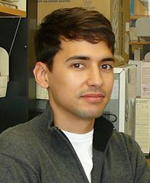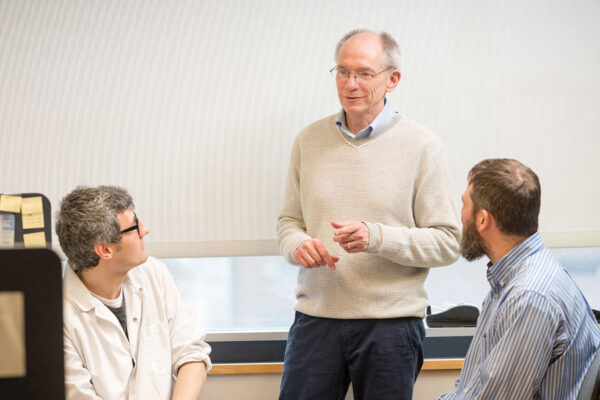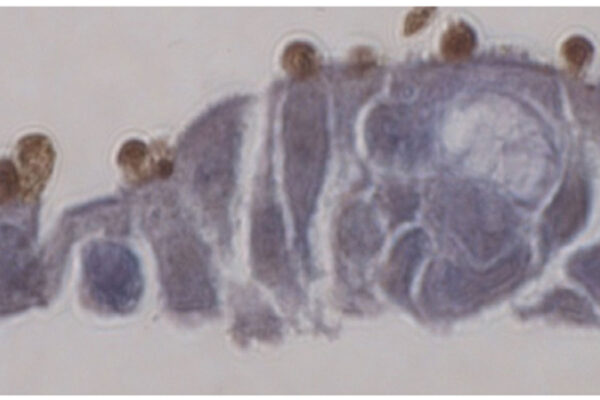Researchers at Washington University School of Medicine in St. Louis have identified a parasite protein that has all the makings of a microbial glass jaw: It’s essential, it’s vulnerable and humans have nothing like it, meaning scientists can take pharmacological swings at it with minimal fear of collateral damage.
The protein, calcium dependent protein kinase 1 (CDPK1), is made by Toxoplasma gondii, the toxoplasmosis parasite; cryptosporidium, which causes diarrhea; plasmodium, which causes malaria; and other similar parasites known as apicomplexans.
In the May 20 issue of Nature, researchers report that genetically suppressing CDPK1 blocks the signals that toxoplasma parasites use to control their movement, preventing them from moving in and out of host cells. They also found that toxoplasma’s version of CDPK1 is easier to disable than expected and identified a compound that effectively blocks its signaling ability.
“Kinases are proteins that are common throughout biology, but the structures of CDPKs in apicomplexans much more closely resemble those found in plants than they do those of animals,” says senior author L. David Sibley, PhD, professor of molecular microbiology. “We showed that these differences can be exploited to identify potent and specific inhibitors that may provide new interventions against disease.”
Infection with toxoplasma is most familiar to the general public from the recommendation that pregnant women avoid changing cat litter. Cats are commonly infected with the parasite, as are many livestock and wildlife. Humans also can become infected by eating undercooked meat or by drinking water contaminated with spores shed by cats.
Epidemiologists estimate that as many as one in every four humans worldwide is infected with toxoplasma. Infections are typically asymptomatic, only causing serious disease in patients with weakened immune systems. In some rare cases, though, infection in patients with healthy immune systems leads to serious eye or central nervous system disease, or congenital defects in the fetuses of pregnant women.
Sibley studies toxoplasma both to find ways to reduce human infection rates and as a model for learning about other apicomplexans, such as plasmodium, that are more significant sources of disease and death.
 Lourido
Lourido
The new study, led by graduate student Sebastian Lourido, began as an effort to determine what CDPK1 does for toxoplasma. Researchers genetically modified the parasite, eliminating its normal copy of CDPK1 and replacing it with a version of the gene that they could turn on and off. When they turned the new gene off, they found that they had paralyzed the parasite, preventing it from moving and from breaking into and out of host cells. Turning the gene back on restored these abilities.
Further tests revealed that CDPK1 controls toxoplasma’s ability to secrete microneme proteins, sticky proteins that act as handholds and allow the parasites to move about their environment and pass through host cell membranes.
In a separate collaborative paper published earlier this month in Nature Structural and Molecular Biology, scientists in the laboratory of co-author Raymond Hui, PhD, principal investigator of parasitology at the Structural Genomics Consortium of the University of Toronto, determined the three-dimensional structure of the CDPK1 protein. Researchers found that the area drugs would normally bind in order to disable the protein was more accessible than in virtually all other kinases, including those that control signaling in humans.
“To our surprise, CDPK1 just has a naturally large keyhole for inhibitors to slide into,” Lourido says. “This good fortune allowed us to exploit bulky kinase inhibitors that had been previously pioneered by the laboratory of Kevan Shokat, PhD, professor of cellular and molecular pharmacology at the University of California, San Francisco, and a Howard Hughes Medical Institute investigator.”
When tested on parasites, the bulky inhibitors successfully blocked CDPK1 function and parasite infectivity without affecting human cells.
Lourido suspects CDPK1 may play a similar role in plasmodium, but its version of the protein is predicted to be harder to selectively target with inhibitors. Little is known about what CDPK1 does in cryptosporidium, but since it shares close similarity to toxoplasma, it may also be essential and susceptible to inhibition by similar compounds.
Sibley and Lourido plan to learn more of the details of how CDPK1 controls microneme secretion, using toxoplasma as a model to study the functions of parasites and how they differ from human cells. The successful toxoplasma inhibitor is now undergoing further testing in animals to see if it can eventually be adapted for clinical use to prevent infection in humans.
Lourido S, Shuman J, Zhang C, Shokat KM, Hui R, Sibley LD. Calcium-dependent protein kinase 1 is an essential regulator of exocytosis in Toxoplasma. Nature, May 20, 2010.
Funding from the American Heart Association and the National Institutes of Health supported this research.
Washington University School of Medicine’s 2,100 employed and volunteer faculty physicians also are the medical staff of Barnes-Jewish and St. Louis Children’s hospitals. The School of Medicine is one of the leading medical research, teaching and patient care institutions in the nation, currently ranked fourth in the nation by U.S. News & World Report. Through its affiliations with Barnes-Jewish and St. Louis Children’s hospitals, the School of Medicine is linked to BJC HealthCare.


